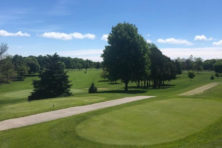Match Play: The oldest, simplest and purest form of golf competition
- Share
- Tweet
- Pin
- Share
Golf is perfect for über competitive people. The kind of folks who get upset playing cornhole or beach volleyball, even rock-paper-scissors.
In one sense, few other sports allow you to compete against hundreds of other people simultaneously. Then at the same time, there’s the personal competition always lurking, where a number (your handicap) constantly defines your game, and only you can make it better. And it never ends; any time you’re keeping score, that competition exists against yourself circa last round, last week, even your last decade.
It’s that evergreen competition that invigorates some of the greatest athletes in the world. Stephen Curry, Aaron Rodgers, Bryce Harper and a number of various Most Valuable Players get their competitive offseason release on the golf course.
Many times, though, the competition really isn’t fierce. It’s not easy to find four friends whose “good days” and “bad days” match up well. The difference in skill level is not easy to standardize, except in match play. Match play is simple; it’s one player (or one team) against another player (or another team). Each hole is its own competition where the amount of strokes dictates a won, lost or halved hole. It’s the oldest, simplest and purest form of golf competition.
If it’s unclear why match play matters to the Door County populace, and why it matters now, look no further than the TV guide. The greatest display of match play golf will be on your TV screen very soon.
This month (Sept. 27-Oct. 2), the Ryder Cup is back, and not too far from Door County (at Hazeltine National Golf Club in Chaska, Minnesota, near the Twin Cities). Twelve of the best American players will face off against 12 of the best European players in a series of matches. On Friday and Saturday, they’ll play alternate shot (also known as foursome, with two teammates taking turns playing the same ball toward the hole) and best ball (AKA fourball, where a team of two each plays their own balls and taking the best of the two scores). On Sunday, 12 singles matches decide the fate of the event.
While it’s never easy to get sports fans to turn off football, the Ryder Cup presents golf like it is so rarely seen. The sport known for 140-man races to the top of a leaderboard (with millions of dollars at stake) reverts to its oldest form of man-to-man golf, filled with strategy, gamesmanship and guile. But most importantly, it’s filled with nerves.
The nerves are how you understand the importance of the stage. Even the best golfers on the planet have crumbled under team golf pressure, asserting that the tension and weight of 11 fantastic golfers on their shoulders became too much. Inherent nerves build the opportunity for excitement. You’ll find that at the Ryder Cup, too. It is the only time professional golfers will actually beg the crowd to scream as they hit their first tee shot, like Ian Poulter and Bubba Watson did at the 2012 event near Chicago.
In four years, the event will visit Wisconsin at Whistling Straits. This time, as the Ryder Cup visits our westerly neighbor and you happen to scroll past NBC with your remote, at least take note. The Packers will be on their bye week, after all.
Sean Zak is an assistant editor at GOLF Magazine and Golf.com in New York City, where he has learned that writing about golf is just as difficult as playing it.

